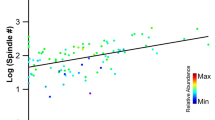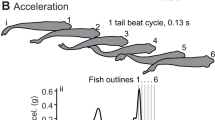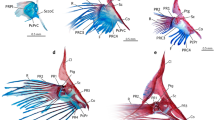Abstract
In many groups of vertebrates, the muscle spindle is a specialized sensory organ for the detection of muscle stretching. The structure of the spindle varies among vertebrate classes1–3. Moreover, Barker2 has asserted that Amphibia are the most primitive vertebrates to possess muscle spindles. Extensive studies, made mainly on the locomotor myotome4–11, seem to show that the muscle receptors of fish are less specialized than those of more advanced animals, and that muscle spindles are absent. However, little attention has been paid to the jaw-closing muscle. We report here our finding of a very simple muscle spindle with a single intrafusal fibre in the well-developed jaw-closing muscle, adductor mandibulae, in a primitive teleostean, Oncorhynchus masou (Brevoort).
This is a preview of subscription content, access via your institution
Access options
Subscribe to this journal
Receive 51 print issues and online access
$199.00 per year
only $3.90 per issue
Buy this article
- Purchase on Springer Link
- Instant access to full article PDF
Prices may be subject to local taxes which are calculated during checkout
Similar content being viewed by others
References
Crowe, A. & Ragab, H. M. F. J. Anat. 106, 521–538 (1970).
Barker, D. in Handbook of Sensory Physiology Vol. 3, Pt 2 (ed. Hunt, C. C.) 1–190 (Springer, Berlin, 1974).
Guth, K. F. in Biology of the Reptilia Vol. 2 (ed. Gans, S.) 266–355 (Academic, New York, 1981).
Greene, F. C. & Greene, C. H. Bull. Bur. Fish. Wash. 33, 25–59 (1913).
George, J. C. Am. Midline Nat. 68, 487–494 (1962).
Bone, Q. in Fish Physiology Vol. 7 (eds Hoar, W. S. & Randall, D. J.) 361–424 (Academic, New York, 1978).
Bokdawara, F. D. J. Anim. Morph. Physiol. 14, 60–68 (1967).
Hudson, R. C. L. J. exp. Biol. 58, 509–522 (1973).
Patterson, S., Johonston, I. A. & Goldspink, G. J. Fish Biol. 7, 159–166 (1975).
Mosse, P. R. & Hudson, R. C. L. J. Fish Biol. 11, 417–430 (1977).
Johnston, I. A. Symp. zool. Soc. Lond. 48, 71–113 (1981).
Hines, M. Proc. Res. nerv. ment. Dis. 9, 124–137 (1930).
Proske, U. J. Anat. 105, 217–230 (1969).
Barker, D. & Cope, M. J. Anat. 96, 49–57 (1962).
Maeda, N. Anat. Anz. (in the press).
Kubota, K. & Masegi, T. Anat. Rec. 172, 703–710 (1972),173, 353–364 (1972); J. dent. Res. 51, 1080–1091 (1972).
Kubota, K., Masegi, T. & Osanai, K. Bull. Tokyo Med. Dent. Univ. 21 Suppl., 3–6 (1973); Acta anat. nippon. 48, 73 (1973).
Author information
Authors and Affiliations
Rights and permissions
About this article
Cite this article
Maeda, N., Miyoshi, S. & Toh, H. First observation of a muscle spindle in fish. Nature 302, 61–62 (1983). https://doi.org/10.1038/302061a0
Received:
Accepted:
Issue Date:
DOI: https://doi.org/10.1038/302061a0
This article is cited by
-
Sensory interaction with central ?generators? during respiration in the dogfish
Journal of Comparative Physiology A (1988)
Comments
By submitting a comment you agree to abide by our Terms and Community Guidelines. If you find something abusive or that does not comply with our terms or guidelines please flag it as inappropriate.



